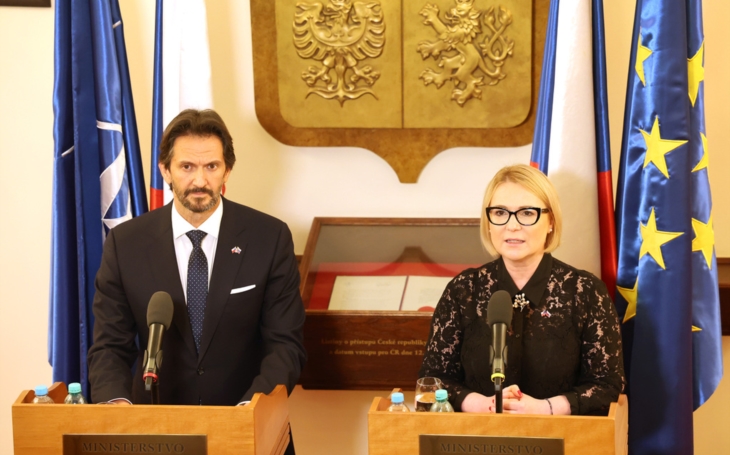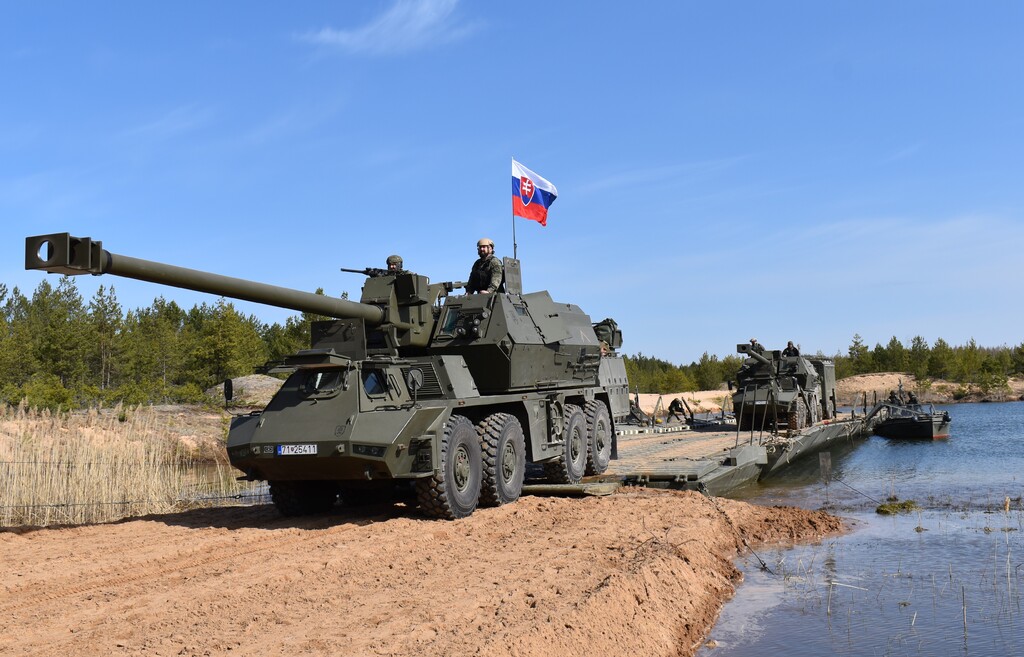
foto: Ministerstvo obrany, Public domain/Robert Kaliňák and Jana Černochová
The Ministry of Defense claims that part of the strategy for negotiating the joint purchase of Slovak ammunition is to achieve maximum self-sufficiency in order to secure supplies. However, domestic production capacities are clearly threatened by this intention.
In an interview with Echo24 entitled “Řehka disappointed me as a person, says Černochová,” on January 13 of this year, the Minister of Defense said the following about joint purchases with Slovakia: “On the sidelines of the talks in Ramstein, I had a meeting with my Slovak colleague Robert Kaliňák, because we are from the same region and we agreed on the same procedures. They are buying Tatra trucks together with us, and we, in turn, can buy some ammunition and support the increase in production capacity in our region.”
Joint purchases are not just about tank and medium-caliber ammunition
Supporting the increase in production capacity in our region sounds very nice, but it is important to know which production capacities will be supported and where. The declaration signed by Černochová and Slovak Defense Minister Kaliňák states, among other things, that both countries “have introduced or are planning to procure and introduce new military equipment using the same ammunition, primarily 120 x 570 mm tank ammunition, 30 x 173 mm cannon ammunition and, where appropriate, other ammunition and ammunition components…” Slovakia, like the Czech Republic, received Leopard 2A4 tanks from Germany as part of a so-called circular exchange in compensation for heavy equipment sent to Ukraine.
The Czech Republic expects to sign a contract for the purchase of up to 77 Leopard 2A8 tanks, and the issue of modern tanks is also being addressed in Slovakia, with various solutions being mentioned, ranging from the Leopard 2A8 to the South Korean K2 tank and “light tanks” or CV90120 fire support vehicles – all of which would use standard 120 x 570 mm ammunition. The 30 x 173 mm medium-caliber ammunition is intended for wheeled and tracked infantry fighting vehicles in the Czech Republic and for the Patria AMV XP wheeled armored vehicles in Slovakia, while the tracked BVP CV90 will be armed with 35 mm cannons in the Slovak Armed Forces.
The key phrase in the declaration is “and possibly other ammunition,” which undoubtedly hides the bone of contention between the two largest defense industry companies in our country: STV and CSG. This refers to 155 mm NATO artillery ammunition, which is the standard caliber for Western artillery systems. In the Czech Republic, this is used in French CAESAR self-propelled howitzers, for which ammunition will be supplied by Martin Drda’s STV Group under a 12 billion contract. In Slovakia, the howitzers are Zuzana 2, manufactured by MSM Group, part of Michal Strnad’s Czechoslovak Group. STV Group strongly opposed the plan to purchase this ammunition in Slovakia at the end of June, when its owner stated that in such a case, the company would reconsider its $5 billion investment in production capacity, which would prevent the planned creation of 1,200 jobs.
The Ministry of Defense wants to achieve maximum self-sufficiency by purchasing Slovak ammunition
On July 16, the Ministry of Defense published a response to a request for information under Act 106. One of the questions was: “What are the expected impacts of this approach on the development and maintenance of strategic production capacities in the Czech Republic? Are long-term self-sufficiency and industrial security taken into account in defense planning?” The Ministry replied: “The acquisition process includes an assessment of the impact of public procurement on municipalities in the Czech Republic. Moreover, the Ministry’s strategic documents also indicate a priority to develop the industrial base in the Czech Republic, and even a potential joint purchase, which is the subject of the request for information, is no exception. Yes, part of the negotiation strategy is to achieve maximum self-sufficiency to ensure the supply of strategically important ammunition and industrial security of supply.”

Is achieving maximum self-sufficiency part of the negotiation strategy with Slovakia? “They buy Tatra trucks with us, and we, in turn, can buy some ammunition and support the increase in production capacity in our region,” according to a January statement by the Minister of Defense, which basically means that while Slovakia has purchased Tatra vehicles from intermediary Tatra Defense Systems of the Czechoslovak Group, the Czech Republic will reciprocally purchase ammunition from a Slovak ammunition manufacturer belonging to the same Czechoslovak Group and support its production capacity. “Our region” in this context is not the Czech Republic or Central Europe, but primarily Michal Strnad’s region.
If this actually happens and STV Group does not implement its investment plan to expand production capacity in Polička, Jana Černochová will find it very difficult to defend her actions. This is especially true if there is no public tender for the supply of ammunition under this joint purchase, which is the only way to provide a clear answer to the question of the economic benefits of such a purchase. And if the domestic manufacturer says that it will not expand its domestic production capacity in the event of ammunition purchases in Slovakia, what maximum self-sufficiency is the Ministry of Defense talking about?
ReArm Europe as an opportunity and a risk
The joint purchase could be financed by the European ReArm Europe program. This program supports joint purchases by at least two EU countries, which suggests potential economic benefits through cost sharing and the involvement of the European defense industry. The problem lies in the details, and in a situation where both countries have production capacity, but priority should be given to developing production capacity in one country, with the support of European funds, there is significant friction. When it comes to joint ammunition purchases, such an approach would make sense between two countries, one of which does not produce ammunition.
Joint purchases could bring financial benefits thanks to the possibility of drawing on the European package of EUR 150 billion, provided that the European defense industry accounts for at least 65% of the contract. This initiative could reduce the cost of ammunition for both countries. At the same time, however, it could easily create a dependency of the Czech Republic on Slovak production. Ammunition is a “consumer good,” and in times of crisis, every country will think first and foremost about its own needs, and only then about the needs of its allies.
Tagy